Landing rules
For planting a culture to be successful, you need to take into account a number of features.
At the same time, it is important to correctly choose the bulbs and container for growing seedlings.
Choice of capacity
To grow peonies at home, you need to choose the right pot. In this case, one must take into account the size of the plant.
It is important to understand that culture needs a large area. A suitable option would be a container with a diameter of 50-60 cm, a depth of 30-40 cm
Larger varieties will need even more volume
Equally important is the presence of drainage holes at the bottom of the tank. The optimal solution would be pots with a volume of 5 liters.
Note! Peonies can be grown in wooden crates. To do this, they should be covered from the inside with a dense non-woven material.
Preparing seedlings for planting
When buying a seedling, you should carefully study the condition of the stem and root system. There should be no areas of decay or mold on the planting material. If the plant has been damaged due to improper storage, excess fragments should be cut off. This is done with garden shears or pruning shears. It is recommended to make cuts obliquely and sprinkle with wood ash.
When growing peonies at home, it is worth treating them with a solution of potassium permanganate. This tool has disinfecting properties. Before planting, there should be 1-2 buds on the cut. If the eyes do not develop, the stalk must be placed in the refrigerator. When buds are formed, the plant can be planted in the ground.

Before planting the tubers should be treated with a solution of potassium permanganate
Preparation or selection of soil mixture
In order for indoor peonies to develop well, it is recommended to fill the pots with a mixture of soil with the addition of peat. Plants must be planted in a container with a drainage layer. Thanks to this, it is possible to avoid stagnation of water, which provokes rotting of the roots.
Important! You can make the substrate yourself. To do this, it is recommended to mix humus, garden soil and river sand in equal parts.
Step-by-step instructions for planting in a pot
To plant a crop correctly, it is worth doing the following:
Place the tuber perpendicular to the wet soil
When choosing its location, it is important to ensure that the kidneys are directed upward.
The flower reacts negatively to constant transplants. Therefore, it is not recommended to use too small containers for planting.
Sprinkle the plant with soil on top and water it abundantly.
Important! In the spring, you can feed the soil with fertilizer with a small amount of nitrogen. You can buy it in a specialty store.
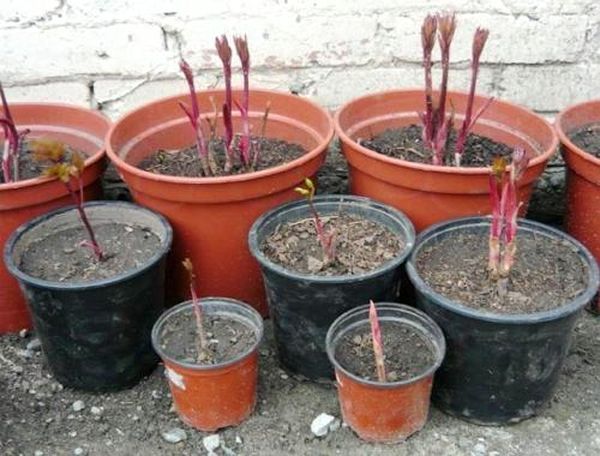
Planting peonies in a pot requires a number of conditions.
Further care of the flower
After planting a peony, so that it takes root in a new place as quickly as possible and grows, you need to organize correct and balanced care for it.
The planted flower should be placed on an unshaded light windowsill. The light must fall on the peony for at least 12 hours in a row. If there is not enough light, it is necessary to install additional illumination, organized using fluorescent lamps.
Indoors, it is recommended to place the pot on the windowsill of windows facing the southeast and south sides. In this case, the flower should be protected from drafts. You can even put a container with a plant on a glazed balcony, terrace or loggia.
Watering the plant is done regularly. Water should be added after the top layer of earth (2 cm thick) is completely dry. At the end of summer, watering is reduced to allow the flower to smoothly transition to a dormant state.At the same time, the lighting period should be gradually reduced, as well as the room temperature should be lowered.
Additional spraying of the peony is not carried out. It also does not need high humidity in the room. However, it is forbidden to put a flower pot near heating appliances.
In the process of growth, the peony should be periodically fed, since this plant consumes a lot of nutrients, which leads to a rapid depletion of reserves of mineral components in the soil. Top dressing is performed in three stages:
- after the formation of the first stems, nitrogen-potassium fertilizers must be added to the container. They will stimulate the peony to grow shoots;
- during budding, fertilizing with potassium, phosphorus and nitrogen is performed. These substances will allow the flower to form large buds;
- 14 days after the beginning of flowering, phosphorus and potassium are reintroduced, which will allow the plant to recover after the budding period.
Each season, the fertilizing cycle is repeated.
Care
In order for a plant to grow healthy and strong, it is necessary to create the most comfortable conditions for growth and development for it.
A light-loving flower needs a lot of sunlight. The peony should be placed on windowsills on the south and east side, where it is very light for 12 hours. In places with low light levels, additional sources of artificial light should be installed. Fluorescent lamps should be at least 20 centimeters higher than the plant and work about 14 hours a day. Experienced flower growers recommend connecting special timers to artificial light sources to automatically turn on the light in the morning and turn off the device in the evening.


Peony has a negative attitude towards strong wind currents and nearby heating devices. During the summer season, experienced gardeners recommend placing flower pots only on glazed areas and balconies.
The plant needs regular and moderate watering. To prevent waterlogging of the soil, watering should be carried out only after the upper soil layer has dried up to 2 centimeters deep.
At the beginning of autumn, it is necessary to significantly reduce the number of watering, the level of illumination and reduce the temperature regime for the comfortable adaptation of the flower to the dormant period. Peony does not need spraying and high humidity levels.

Peony needs a lot of nutrients to form bright, large and beautiful flowers.
- In the spring, the pet needs mineral fertilizers, which contain a large amount of nitrogen and potassium. These mineral elements will allow the flower to form strong and powerful shoots.
- During the budding period, the plant must be fed with potassium, phosphorus and nitrogen, and 2 weeks after the beginning of flowering, phosphorus and potassium must be added to the soil.
This system of feeding pets should be carried out annually.
If the rules of care are not followed, the plant will have a sluggish and unhealthy appearance, as a result of which it will not be able to form fragrant and beautiful flowers.
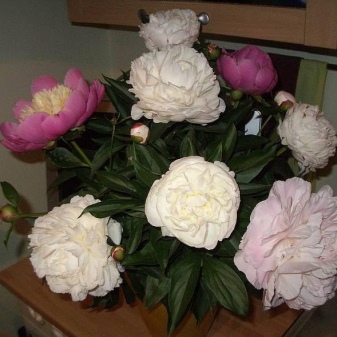
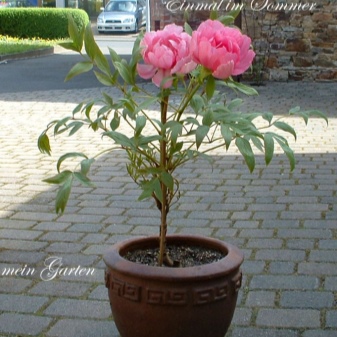
The most common problems when growing homemade peonies:
- sluggish leaf plates and lack of buds - low light level;
- slow formation of new shoots - insufficient application of nitrogenous fertilizers;
- rapid formation of green mass and the absence of buds - the implementation of deep planting of rhizomes.
If water gets on flowers, fungal diseases and dangerous pests may develop.
How to properly plant peonies in a pot, see the video below.
Digging and rinsing peonies
Difficulties with digging up peonies are associated with the peculiarities of their root system. Usually, in the 4-5th year, it grows to a great depth, individual rhizomes reach a length of 30 cm or more. The tips of the roots are often thin and go even deeper into the soil.It is very difficult to dig them out without damage, so several recommendations should be considered:
1. Peonies should be dug in dry and warm weather, so that the lump of earth that you will take out along with the roots is not too heavy.
2. Place the shovel 30-40 cm from the center of the bush and place it vertically. If you place it obliquely, you will most likely chop off the tips of the roots.
3. Dig in the bush on all sides and carefully lift it out of the ground. You can place shovels or garden forks under the chute, such as a brick. Thus, the shovel will act as a lever. Do not use too much force, otherwise the instrument may break. It is better to dig in the bush more thoroughly again.
4. In no case pull the peony by the leaves (especially if the bush is more than 5-6 years old). Do not forget that before digging out the stems must be cut off, leaving hemp 5-10 cm high. It is for them, smoothly and effortlessly, that the plant should be pulled.
Even if you did everything correctly, some of the roots will be damaged anyway. Clean the rhizome from any clods of soil and rinse thoroughly under running water, since a clean base is easier to mark and divide. It is also necessary in order to assess the condition of the kidneys and roots. After all, if in recent years the plant has stopped blooming, it is likely that it has already begun to rot.
Peony transplant
When to transplant peonies
Wild peonies grow in one place for up to fifty years or more. Hybrid varieties that originated from the medicinal peony can grow without transplanting in the same area for no more than ten years, after this period, the bush must be divided and transplanted to another place. In addition, dividing and planting a bush is the easiest and most reliable way to reproduce peonies. But for this purpose, 4-5-year-old bushes are used, which have already fully bloomed once or twice. The fact is that the root system of peonies grows strongly over the years, so it is easier to cope with a younger rhizome than with an old one, so in order for the quality of the flowering of your peonies not to decrease, it will be better to divide and plant the bushes every three to four years ... Peonies are transplanted in September.
In the photo: White peony flower
Transplanting peonies in autumn
How to transplant peonies? In autumn, the bush is dug in at a distance of 25 cm from the rhizome, then carefully loosened with a pitchfork and removed from the ground. The rhizome is cleaned from the soil with a peg, then washed with a not very strong jet of water, so as not to damage the fragile buds-eyes of peonies
The ground part is cut almost to the root. The washed rhizome is left in the open air so that the water is glass, and the roots are slightly wilted and become more elastic. Then the old thick roots are pruned to a length of 10-15 cm at an angle of 45 °.
Examine the root carefully and only then proceed to division.
If the bush is old, then it is most convenient to drive a wedge into its middle with a hammer, which will split the rhizome into several parts. Often in the middle of old rhizomes there are voids and rotten areas that need to be cleaned out, disinfected with a strong solution of potassium permanganate, and then powdered with fungicide. Delenki should consist of a part of the root collar with well-developed 3-4 eyes and several roots. It is necessary to try to divide the rhizome into approximately equal parts, so that there are neither too large divisions that will hurt for a long time after transplantation, nor too small ones that may die.
In the photo: Growing peonies in the garden
How to transplant peonies
It is necessary to plant the cuttings in the ground in the way that has already been described. The area with transplanted plants for the winter must be mulched with a seven-centimeter layer of peat, you can remove the mulch when in the spring reddish peony sprouts break through it. In the first two years after transplanting, peonies should build up a root system, so be patient and do not let young plants bloom.In the first year, pinch off all the buds that appear, the next - leave only one bud on the bush and, when it bursts, cut it as short as possible and consider how the flower matches its variety. If the match is incomplete, then you will have to pinch off the buds for another year, leaving only one until the flower fully matches its variety. This can happen in the third year, and maybe in the fifth.
Landing rules
The most favorable time for planting plants is the beginning of spring. For planting homemade peonies, you must choose flower pots, the volume of which is at least 5 liters, and the diameter is from 25 centimeters. The optimum height of the landing container should be 45 centimeters.
You can plant peonies not only in classic flower containers or pots. Wooden boxes are also quite suitable for this, the inner surface of which is closed with a dense non-woven material.

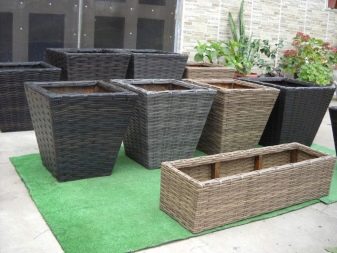
When making your own soil mixture, you need to mix river sand, humus, peat and garden soil. A small amount of bone meal, ash and superphosphate must be added to this composition.
For planting, it is necessary to choose shoots from the root system of those plants whose age does not exceed 3 years. Planting material can be planted only after the first buds appear. Until this moment, the scions must be stored in the refrigerator.

The list of basic activities that will help you plant a decorative peony correctly:
- selection of a flower container;
- the formation of a drainage layer, which may consist of fine grained pebbles, broken brick and perlite (a layer of 3-5 centimeters);
- shelter of pebbles with coarse sand (but not river sand!);
- filling the planting tank to the middle with nutrient soil;
- placement of selected roots on the ground, the buds of which should be directed upward;
- filling all voids with a nutrient mixture;
- the formation of a surface peat layer;
- abundant soil moisture.

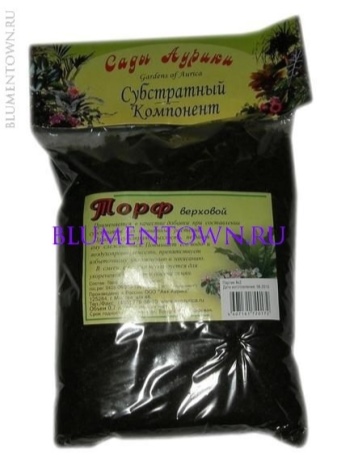
This flower has a negative attitude towards frequent transplants. Experts recommend not using very small landing containers for planting.
Subject to all planting rules, the plant will be able to form buds in a few months.

Drainage in the planting pit for peonies
Many novice flower growers, anxious about how to plant peonies in the garden, are interested in whether drainage is needed at the bottom of the pit? Quite often in the literature for drainage, it is recommended to pour a layer of rubble, stones and broken brick on the bottom of the pit. But such a recommendation cannot be universal and it is not entirely clear when it will be useful. If the soil around the pit, especially from the bottom, is clayey, there is no benefit from drainage, as from shards at the bottom of a pot without holes, there is still nowhere for the water to go. And if the soil around the pit is sandy, you do not need drainage, but, on the contrary, clay in the lower layer of the pit in order to keep moisture there longer.
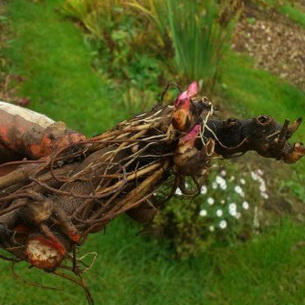

Local drainage in the planting pit when planting peonies will not protect the flowers from nearby groundwater. In this case, it is necessary to install a general drainage system at the planting site, which can lower the level of standing groundwater. Or drainage grooves if the landing site is lowered. For the latter case, bulk elevated ridges have already been recommended.
What conditions must be observed when caring for a decorative peony
For good growth, lush flowering, perennials need suitable conditions.
Pay attention to the following points:
- temperature;
- watering, humidity level;
- lighting;
- the use of fertilizers.
Temperature
In a very warm room, the peony stops rooting. Recovers at a temperature of 10-15 ° C. The plant hibernates at 5-8 ° C.
Watering and humidity
The perennial is watered with water at room temperature with a dried surface of the earth up to 1.5-2 cm. The liquid is distributed over the entire surface of the container, the flowers cannot stand abundant watering. Remaining moisture must escape through the drain hole.At the end of summer, the frequency of watering is reduced: they wait for the soil to dry completely in the dishes, then they only moisten the soil.
Note! The flower does not tolerate spraying, droplets falling on leaves and petals
Lighting
For the development of inflorescences, the lightest place for peonies in the apartment is allocated. The south side of the room will work well. It is not always possible to find a sufficiently illuminated place; in this case, an LED phytolamp helps out lovers of peonies. Due to the light spectrum, active growth is ensured. The device can be brought close enough to the leaves, the LED has a low voltage, which increases its safety when water hits the body. The time for using artificial lighting is shortened at the end of August, since preparations for the dormant period begin in this month.
Top dressing
When the first stalks appear, the soil begins to be fertilized. The plant is fed once every 30 days. To do this, use prepared mixtures for perennial flowers, feeding stops at the beginning of autumn. Ash, sand are used as protection against mold; ready-made fertilizers with nitrogen are selected in flower shops. During the ripening of the buds, potassium is added to the ground, as well as phosphorus. When the shoots reach 10 cm in height, fertilizing is applied once every 14 days.
How to care for a peony in winter
In winter, reduce the frequency of watering. Place the pot in a cooler and less lit place. This is done in order not to provoke the beginning of the growing season. The flower is left dormant for the winter.
Home cultivars
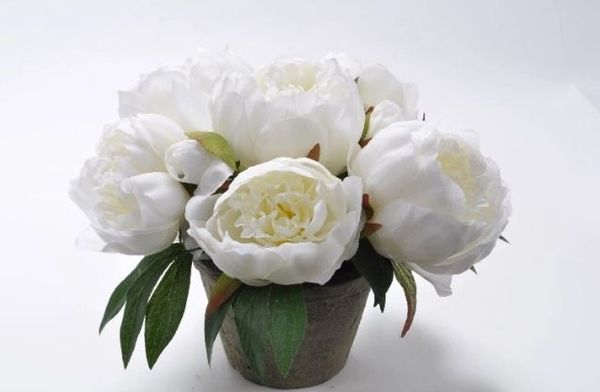
First of all, it is worth deciding which varieties can be grown in an apartment or house. The fact is that the peony is a rather tall and voluminous bush that is unlikely to fit in an ordinary flower pot. And it is very difficult to grow such a plant in an apartment. Therefore, flower growers recommend choosing special varieties for home growing.
Garden varieties form bushes with a height of about 60–120 cm. Therefore, they are not suitable for an apartment, as they require a lot of space, large pots and special care. Low-growing species (patio peonies) that do not grow taller than 50 cm are best suited for home conditions. Patio species form slightly smaller buds than regular garden varieties. The color of flowers can be very diverse: from white to rich or maroon. However, despite their small size, their flowers exude a pleasant aroma. Due to the small size of the plants, their root system is small and fits easily into a flower pot.
It is best to plant the following varieties of peonies in an apartment:
- Rome. Forms pink buds. Has an average flowering period;
- Moscow. The plant blooms with red double flowers. This is a mid-early variety;
- Oslo. Raspberry buds of a simple type are formed on the bush. Very early flowering variety;
- London. Differs in early flowering period. The buds are terry and painted in burgundy color.
Such species on the windowsill can be grown with little effort and time.
Growing indoor peonies at home
Peonies are a spectacular decoration of gardens, a powerful shrub with large and fragrant flowers. But growing such a bush at home is not easy. If it is not possible to create optimal conditions for growth for a potted peony, its shoots grow weak, lethargic, and flowering does not come. Only with some effort can you achieve that the garden plant will become a decoration of the residential interior, the result sometimes exceeds expectations.
Common varieties of garden peonies reach a height of 60-120 cm, so growing them indoors requires a lot of space. Low-growing varieties are more popular among lovers of indoor plants - patio peonies, reaching half a meter in height. Their varieties:
- “Rome” is a medium-flowering variety with pink flowers;
- “Oslo” is a variety with simple raspberry flowers, very early flowering;
- “Moscow” - medium-early variety with semi-double red flowers;
- “London” is an early variety with double burgundy flowers.
The flowers of the patio peonies are slightly smaller in size than the flowers of the garden herbaceous peonies, although they retain their aroma. But they are also characterized by a smaller size of the root system, which allows them to grow undersized varieties in greenhouses. The color palette of these varieties is very diverse: from snow-white to maroon. Flowers are simple, semi-double and double.
For planting in a pot, rhizomes of 2-3 years of age are used. Under optimal conditions, they can begin to bloom a few months after planting. There are 3 main conditions for the successful cultivation of indoor peony:
- 1. spacious container for the root system;
- 2.Long-lasting solar lighting;
- 3. Sufficient supply of water and minerals.
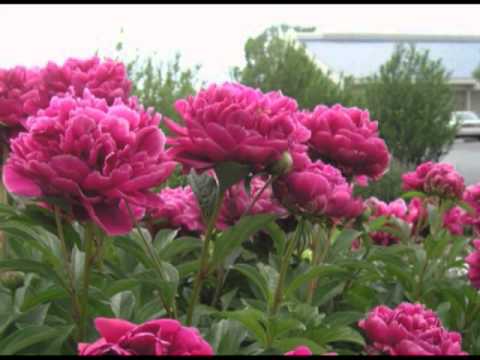
A pot for growing a peony must have a volume of at least 5 liters and a diameter of more than 30 cm. The depth of the pot must exceed the diameter and be at least 50 cm. Such plants thrive in large wooden boxes lined with thick cloth. There must be drainage holes in the bottom of the container in order to avoid stagnation of water and acidification of the roots.
Planting a peony in a pot is carried out in the spring. A layer of coarse pebbles or sand, broken brick, perlite is placed on the bottom of a suitable container for proper drainage, then the pot is half filled with a mixture of garden soil and peat. This layer is well moistened with water, the rhizome is carefully laid on top, buds upward, trying not to damage them. Next, the rhizome is covered with soil, but it should be close to the surface, no deeper than 2-3 cm, otherwise the plant may not start growing. The peony does not tolerate a transplant, so it should be planted immediately in a large pot.
Indoor peony is located in a bright, unshaded place, it needs at least 12 hours of sunlight per day. An open balcony, loggia, terrace are well suited for this. Indoors, the plant should be placed by a wide window in the south or southeast side, but protected from drafts. With a short duration of daylight hours, additional illumination with the help of fluorescent lamps is practiced. Watering is regulated in accordance with the moisture content of the soil - after the complete drying of the top layer of soil 2 cm thick. The plant does not need spraying and does not require high humidity. But you should not place it near heating devices that create a flow of warm dry air.
Large indoor plants consume a large amount of nutrients during the growth process, therefore, the supply of mineral elements in the soil must be regularly replenished. When growing peonies, the application of mineral fertilizers is carried out in 3 stages:
- after the appearance of the first shoots, nitrogen-potassium fertilizers are applied for the growth of shoots;
- during the budding period, fertilizing with nitrogen, phosphorus and potassium is carried out in order to get large flowers;
- 2 weeks after flowering, potassium and phosphorus are added to restore plant resources.
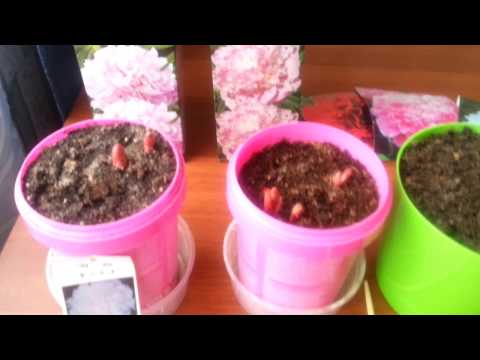
At the end of summer, watering the indoor peony must be reduced to provide it with the conditions for a smooth entry into a state of dormancy. At this time, the duration of the light period is shortened and the growing temperature is lowered.
Even undersized varieties of peonies are difficult to grow in greenhouses. The root system of this plant needs space, and the aboveground part needs an abundance of light. Only by creating optimal growing conditions can peony bloom at home, even though this plant is considered unpretentious in the garden.
{SOURCE}
Features of planting at different times of the year
Healthy and intact suction roots are the key to successful survival of young plants
To determine how to plant peonies and when to do it, you need to have an idea about the features of their root system.
- The central, most massive part of it serves as a kind of storehouse for nutrients. It is she who supports the plant during the wintering period, protects from the cold.
- Thinner processes branch off from it. The density and abundance of flowering of the bushes depend on their condition, since replacement buds and young stems are laid on these roots. Shoots in the form of light, thin root shoots are formed in autumn, in September.
- Another important part of the root system is the suction shoots, which can be represented as a thin web that collects micronutrients and moisture. In order not to damage it, when planting peonies, it is necessary to prepare a wide and deep hole.
In order to choose the right moment when you can transplant peony bushes, you need to know the peculiarities of culture adaptation at different times of the year.
In the spring
The spring transplant of peonies has one significant drawback: it is easy to be late with this work.
With the end of winter, the plants wake up. There is a rapid build-up of suction roots. If during this period you begin to transplant the bush, these roots can be damaged, which threatens the death of the entire plant. It will not receive nutrition and will quickly use up the supply that has accumulated in the massive central roots.
Important! The bushes transplanted in the spring are often overgrown with a dense green mass. But next winter they do not survive, since over the summer their pantry of useful substances is spent, but they are not enough for the winter.
If you still transplant the bushes after wintering, then this should be done as early as possible, immediately after the snow cover disappears, before the plants awaken. At this point, the roots do not have time to wake up. They begin to develop in a new area.
Summer
In June and July, the culture is actively increasing its green mass, and the suction roots have time to grow and gain a foothold in the ground during the spring. Their development slows down, but the roots actively extract moisture and nutrients. When buds form on the bushes, the main forces of the plant are directed to the flowers.
If peonies are transplanted in the summer, then the suction roots are inevitably damaged, the nutrition of the bushes deteriorates. In the new site, neither the development of new roots, nor the adaptation of the old ones take place. The reserves already made by plants become the only source of nutrition. But they are not enough for wintering, which often leads to the death of peonies.
According to statistics, most of the bushes transplanted in the summer period wither within a month.
In autumn
In autumn, peonies stop blooming and begin to prepare for wintering. The green mass is not growing. Plants provide a supply of nutrients. Their absorbing roots actively extract nutrients and grow rapidly. This period is considered the best when planting peonies. The bushes are ready to be divided and moved to a new site. The roots are ready for the winter cold.
For normal rooting of the culture, one month is enough. Before the onset of frost, sucking roots have time to grow in peonies. In the northern regions, planting can be done in mid-August. In the Middle Lane, the optimal time is in September, and in the south it lasts until mid-October.
Note! When replanting bushes in the fall, it is important not to be late. On average, at the end of September, there is a period of active growth of pantry roots, where plants retain a supply of necessary elements. They become denser, more voluminous
The transplant must be carried out before this time, otherwise the bush will not survive in winter
They become denser, more voluminous. The transplant must be carried out before this time, otherwise the bush will not survive in winter
On average, at the end of September, a period of active growth of root-pantries begins, where plants retain a supply of necessary elements. They become denser, more voluminous. The transplant should be carried out before this time, otherwise the bush will not survive in the winter.
How to plant and grow seedlings
Florists with many years of experience recommend planting shoots that are no more than three years old. It is possible to plant the planting material as soon as the first buds appear.
How to do it right:
- Place the tuber perpendicular to the damp ground. When choosing a position, it is necessary that the buds grow upward.
- It should be borne in mind that the flower has a negative attitude towards permanent transplants. Therefore, small landing containers cannot be used.
- To check the recommended depth (2.5-5 cm), place the tuber on top of the potting mix. Compliance with this parameter is considered a priority when planting, as it will ensure the flowering of peonies.
- After determining this indicator, it is necessary to mix the water with the mixture so that it becomes wet.
- In order for the soil to receive the right amount of nutrients before planting, it is necessary to add compost. You can also use special organics.
- In the spring, fertilizer should be applied to the soil with an insignificant nitrogen content. You can buy top dressing in specialized stores.
Features of caring for tree-like peonies in pots
- You should select roomy (up to 25-30 l), thick-walled containers made of decorative ceramics, in which plants can be kept for 5-6 years without transplanting. Containers made of wood or stone with outlets for good drainage are also suitable. Pots made of these materials visually look good and reliably protect the earthy clod around the roots from overheating.
- Planting peonies in plastic flowerpots is also allowed, and in order to protect the roots from excessive fluctuations in ambient temperature, you need to dig them deeper into the ground, approximately on a par with the soil surface in the garden.
- The hydrogel (3-4 spoons), originally added to the potting soil mixture, will also help protect the plants from drying out quickly. After all, the soil in the container dries out pretty quickly.
- Fertilizers should preferably be applied diluted with water, and at a reduced concentration. The balance of the soil in the local space of the container is easily disturbed if the plant feeding is done incorrectly, "by eye". In this case, the risk of excessive stimulation of root growth is not excluded.
- For potted plants, foliar feeding is well suited once a month.
- It is preferable to water from the bottom, pouring water into the pan.
- 65% of the top fertile soil layer and 35% of perlite will provide sufficient soil looseness and good drainage.
- Adult (5-6 year old) plants can be divided and planted in prepared containers.

How to save peonies before planting in spring

If the desire to purchase a peony rhizome of the desired variety at an attractive price turned out to be stronger than a reasonable decision to wait until the right time with the purchase, nothing terrible happened. Peonies can be kept at home and planted in the garden when the time comes.
First, you need to inspect the planting material. If rotten areas or other damage are found on the root of the plant, they must be cut out with a clean knife.
Places of cuts are treated with a raspberry solution of potassium permanganate or brilliant green, or a solution of any fungicide.
If the rhizomes of the peony are in a dormant state, thin young roots are not visible on them and the growth buds have not yet awakened, the peony can be stored in the refrigerator. A herbaceous peony is wrapped in slightly damp moss or a flannel cloth dipped in a phytosporin solution or in plain water.
Then the root is put into a bag (not the one in which the plant was sold!). Make sure to make holes in the bag with an awl for air circulation.
If the kidneys are awake

A common problem: how to preserve a tree peony before planting in the spring, when its buds have already woken up. We'll have to put the cut in a large container (for example, a cut plastic "five-liter").At the bottom of the container, it is imperative to make drainage holes to drain excess moisture.
Coconut substrate, sand mixed with peat or turf soil are chosen as a soil for peony for overexposure. The main thing is that the soil is loose and breathable. The rhizome is immersed in the substrate, leaving only the buds to look out on the surface, from which the aerial part of the plant will begin to grow.
To keep the sprouted peony alive until April-May, the pot with the planted rhizome is placed in a cool place (basement, glazed balcony, cold storage room), where the air temperature is kept within + 5 ... + 8 degrees.
However, this measure is suitable if roots have begun to grow on the rhizome, but the growth buds are still dormant. If the buds have begun to grow, the pot with the plant is placed on the coolest window.
It is better to place the peony on the east window, where the light is not too bright, or shade the leaves that are starting to grow so that they do not burn in the bright spring sun.

A little trick. Experienced gardeners advise, before pouring soil into the pot, line the container with gauze or a fine plastic net (which is hung on windows from insects), bringing the edges of the fabric above the sides of the pot. Then, when transferring the plant from the container to the ground, it is convenient to pull the edges of the fabric and remove the peony without breaking the earthen lump.
Another important point: if the plant has thrown out a bud and is about to bloom, this should not be allowed. Pluck the bud as early as possible so as not to weaken the plant.
Caring for a peony before planting in the ground consists in rare watering with warm water, alternating watering with plain water with a solution of potassium permanganate or phytosporin.


